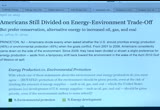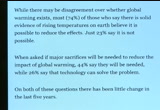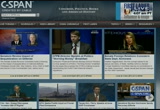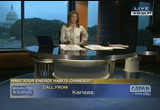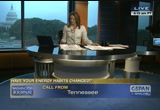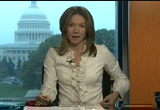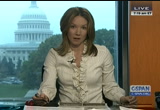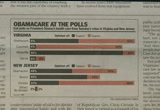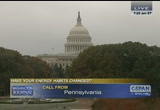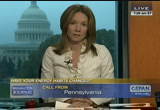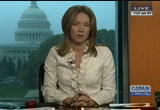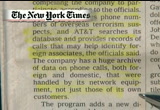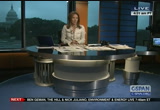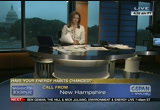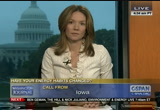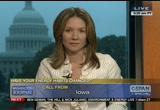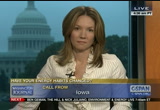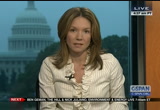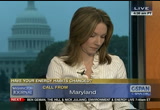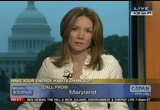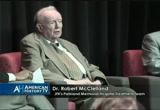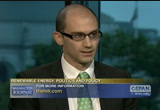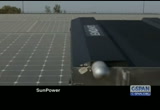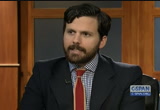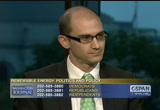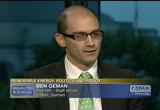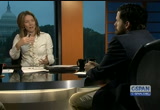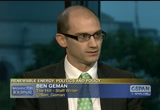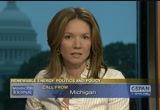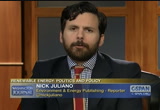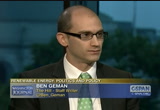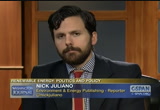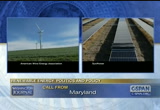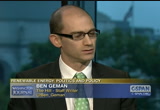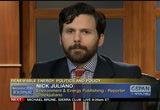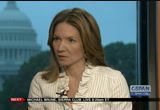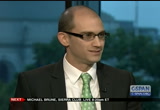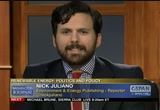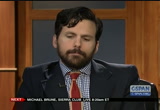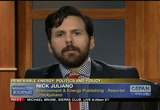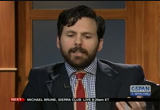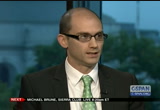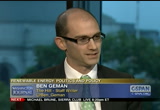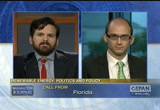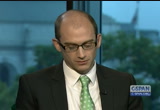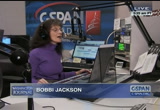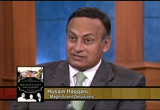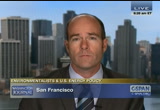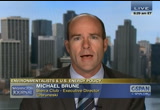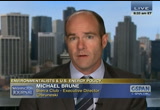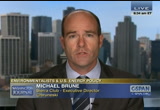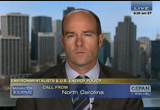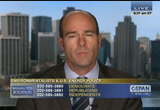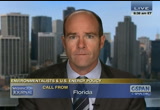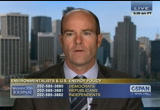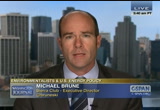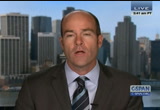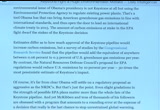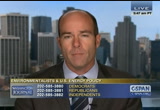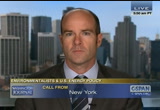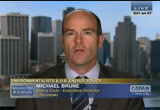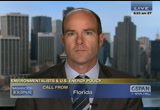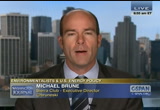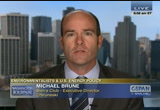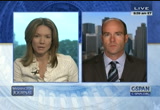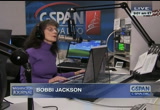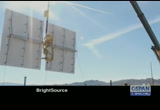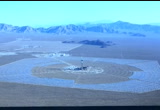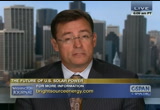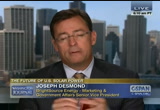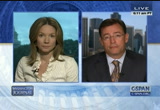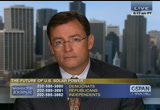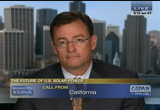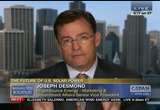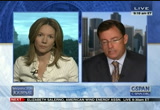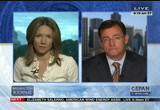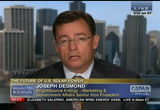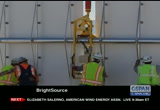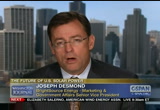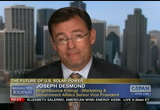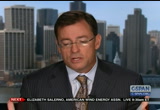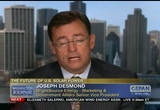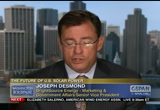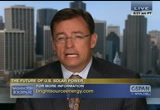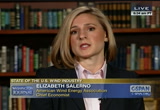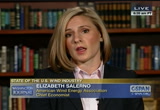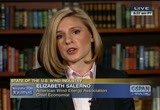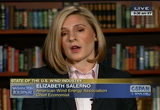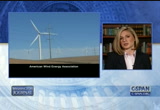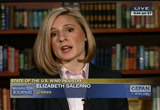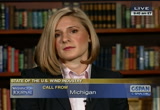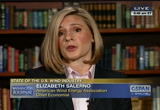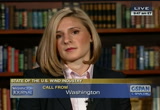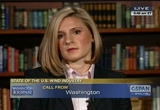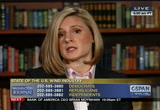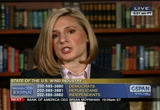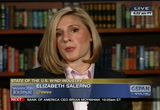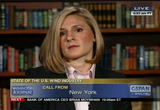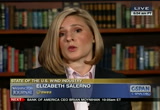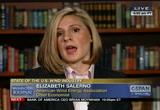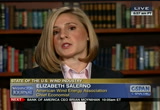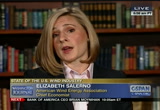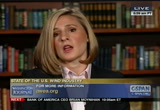tv Washington Journal CSPAN November 7, 2013 7:00am-10:01am EST
7:00 am
and at 9:30, elizabeth salerno of the american wind energy association looks at a report of the wind industry slowdown. ♪ host: good morning, everyone. thursday, november 7. the armed services committee will hear from the army chief of staff and the marine corps commandant about the impact of automatic spending cuts on national defense. live coverage at 9:30 a.m. eastern on c-span3. the epa holds a public listening session on the ways to relieve emission.carbon go to c-span. orc for coverage. sticking with the environment this morning on "washington focusing on renewable
7:01 am
energy. we will kick off with your energy habits. how have they changed over the years? .emocrat, host (202) 585-3880 republicans, (202) 585-3881. independence and all others, (202) 585-5883. send us a tweet at @cspanwj. .-mail us, journal@c-span.org let me begin with a poll taken energy and- the environment trade-offs. from an april 10 poll, americans are still divided on this energy environment trade-off. americans divide evenly when asked whether the u.s. should prioritize energy production, or environmental protection, 45%, when goals conflict. from 2000 one to 2008, americans came down on the side of the
7:02 am
environment. since 2009, they have been divided or showed a preference for energy production. aside from a shift for the environment in the late of the gulf of mexico oil spill in april 2010. have your energy habits changed over the years, what do you think about this? we want to hear from you this morning. more polls. is it possible to reduce the effects of global warming? there may be disagreement over whether global warming exist, most, 74% of those who say there of risingvidence temperatures on earth believe it is possible to reduce the effects. just 23% say it is not possible. when asked if mayors are -- if be neededifices will to reduce the impact of global warming, 44% said they will be needed, web 26% said technology can solve the problem.
7:03 am
there is also this from another poll, more important priority supply.nation's energy developing alternative sources such as wind, solar, hydrogen. 37 republicans say that is important. 71% of democrats say it is important, 60% of independents say that that is an important energy policy. expanding exploration of oil, coal, natural gas, the numbers reversed. of republicans, 22% of democrats, 31% of independents. saying that expanding exploration of oil, coal and natural gas should be a priority. rob, pennsylvania, independent caller. how have your habits changed if they have it all? done what i can
7:04 am
to put myself in a position where i don't have to use a vehicle. if i had a car, i can use public transportation, use a bicycle or walk to work. i have tried to do things around the house like cover the windows with cellophane material or saran wrap. putting an insulated coat on the water heater. if i am gone for it more than a day, i turned the water heater off. i try to do things to help out. host: have you noticed more savings, more money because of that? caller: i do. host: do you know the number? caller: i noticed when i was heating, ik with my go a little bit extreme with my thermostat. if i enable, i will put it down to 50 degrees in the winter. be 20%noticed, it must
7:05 am
or 30% less. host: what about the city that you live in? today make it easy for you to bike around. caller: not necessarily, unfortunately. we don't have a lot of bike paths. with proper lighting, i feel pretty good about writing around -- riding around at night or in the daytime. to make way for you if they are aware that you are making yourself visible. they will go out of their way to make it better for you. energyalking about your habits this morning. on facebook, here are some of the comments. i have always been conscious of the energy i use. energy-efficient appliances, ceiling my windows and doors, turning off my lights. a little common sense goes a
7:06 am
long way. spendys, vermonters more than 800 million. per year investing in using energy efficiently would give them savings. what could a tiny state like milliondo with 400 dollars per year. david, california, independent. hi. you are on air. caller: hello. host: how have your habits changed? caller: i have definitely been using glass. it has been getting a lot more expensive, especially here. i work marginal rates are -- our marginal rates are close to what they are in germany and places like that. force, aso changed by lot of devices that you get today go to sleep. then you have to play with them
7:07 am
and wait for them to come back to life again to use them. that takes a lot of time and energy. there is a lot of silliness going on. carbon dioxide is beneficial. there is not very much of it. host: ok -- caller: it certainly is not making anything warmer or colder for that matter. co2 emissions. the epa at their headquarters in washington is holding a listening session about the best ways to reduce carbon emissions from the nation's power plants. we will have coverage on our website, c-span.org for more information. here is a piece that was posted on al jazeera america's website yesterday. the war of different colored t- shirts. members and other
7:08 am
environmentalists sported t- shirts saying save our communities. others were navy -- wore navy blue ones saying coal keeps the lights on. it was part of a series of 11 hearings organized by the epa, seeking to consult with the public on the development of regulations limiting carbon emissions from power plants. we are asking all of you this morning as we focus on renewable energy, have you changed your energy habits and how so? democrats, (202) 585-3881. -- blicans, democrats, (202) 585-3880 republicans (202) 585-3881 independents and all others,
7:09 am
(202) 585-3882. , or us a tweet @cspanwj post on facebook. lewis, independent color. caller: my habits have changed, i ride a bicycle. host: has the city made that easy for you? caller: no, it is just economic. host: has it saved you money? caller: certainly. host: how much? insurance,on't have i do not have to have a mechanic. i do not have to buy gasoline. tearves money and wear and on the brain. host: all right. virginiatexan tweets in. more and cheaper natural gas for showers. independent caller, hi
7:10 am
there. years to 7the last 5 years, our electric rates go up every year. no matter how efficient we my household, how much less we use, they find a way to hike it up to where it was. i am sitting here, november 7, my house is totally electric. i have not even turned my heating on. my son is 19 years old, we are suffering through. -- ay that making $750 $7.50 an hour you can afford to pay a $400 electric bill. then't understand how system will sustain itself if they price us out of food and electricity. done over have you
7:11 am
the years to try to reduce your electric bill? thing, ite number one is november 7, we have not turn our heat on yet. through the house, we turn off every light and we walked out of the room. effort tomake an unplug everything from the wall once we are not using it. it draws from the plug. different. a little a month or two later, six months, they will send you a rate increase. i will call and complain because they give you a number to call and complain. no matter how much you complain, they still raise it. i don't see how people out here in these small towns that cann't pay anything early, keep paying these high energy costs. i don't really have a solution, i just -- i don't know what is
7:12 am
going to happen to everyone out here that is poor. host: how much of a difference hasn't made? -- has it made? caller: that is just it. it will come down -- host: how much will it come down? caller: let's see, there have been times -- for example, i have lived in this house for 19 years. when we first moved in here, our electric what average, at the highest part of the year, $180 a month. they would would -- send a rate increase, up to like $220. we would try and make it as efficient as possible and it would creep back down. then they would raise it right back up. i have this battle. different, it is a
7:13 am
lot of money to people who are making seven dollars an hour. host: let me ask you this, we read that tweet about natural gas. do you care if your electricity came from coal, natural gas, other sources, fossil fuels? do you want it to come from renewable sources? caller: i want clean, efficient energy. that is going to be affordable to people but also does not harm the environment. i know it is hard to have both, but there is a balance somewhere. they money in energy keeps this from happening. they suppress technology, they stop clean energy product -- projects, they use power and money to keep dirty energy going. host: coming up on "washington talking about
7:14 am
renewable energy standards and an upper on capitol hill to put that into law. we will be focusing on wind power as well as solar here on "washington journal." is it more important to be affordable or clean? this point, it is terrible to say, as an individual trying to take care of a family, affordable. host: from the energy information agency, this is the u.s. sources of electricity from 2012. 12% of electricity comes from renewable energy, solar, geothermal, biomass waste and wo od, wind, hydropower. 19% of that is nuclear, natural gas is 30%, coal 30% -- 37%. risk, democratic -- bruce,
7:15 am
democratic caller. toler: i guess what i wanted say -- we need and all of the above approach. i lean towards nuclear energy. done in my house, i have installed energy-efficient storm windows, double glazed windows. i have installed gas heating, gas hot water tanks, gas cook stove. my wife is retired, she does not have to drive to work anymore, i have cut down to 24 hours. in the summertime, my electric bill will go up, my gas bill will drop. in the winter, vice versa. on average, throughout the year, i am running about $200 per month on gas and electric. we're doing good.
7:16 am
i have installed all of the squiggly bulbs. you know what i am talking about. host: right. caller: i feel good about all of that. host: is saving you money? caller: well, people i talk with -- host: what if it did not save you money? caller: it would have to save to those to go expenses of doing things like that. plus, by using gas, it is a little cheaper. -- itnot quite as carbon is not as dirty as coal. if i was totally electric like i used to be years ago, electric bill would average around $400 a month. what does that tell you? host: on twitter, nothing dirty about solar, wind, water. all electricm,
7:17 am
houses are not efficient. chris, texas, republican caller. good morning. i have moved into a new house two years ago that has the most as ay efficient items such barrier or vinyl windows. it really does save a lot of energy. is theother hand, my job energy efficiency consultant, i go to places around the world and show them how to take their industrial facilities more energy efficient. i do look at a lot of data, carbon dioxide versus temperatures. my conclusion is that the data supports that there really is very poor relationship between carbon dioxide and global
7:18 am
temperatures. wante -- i agree, people to become energy efficient in their homes to save money, that is great. that is what i do. in terms of impact on global warming or climate change, i would say it has a low impact. host: all right. we will keep taking your phone calls on energy habits and how they have changed and what you are doing differently to conserve energy. ofother news, front page "houston chronicle," president obama in texas yesterday defending the affordable care act. admits the flaws but jabs the governor for not giving the state expanded medicaid to help the poor. on the front page of "the wall street journal," worried senators press president obama, leading at the white house.
7:19 am
democrats fear it is taking a political toll from the health- care law. within the wall street journal, abouts the story testimony on capitol hill yesterday from hhs secretary kathleen sebelius. she was up there again for the testifying about the affordable care act, twice in the last two weeks. the headline "exchange site needs hundreds of fixes." yesterday, house government reform committee released documents that showed only 6 people signed up for coverage on -- first day. healthcare.gov that healthcare.gov open. the next is a story about labor unions and the health-care law. administration planning to exempt some labor unions and businesses from
7:20 am
paying part of a contentious healthance fee under the overhaul law. unions and businesses said wednesday that the move would not go far enough. signaled the hyatt intends to propose a break on intends toit i -- propose a break on the fee. and then, healthcare.gov, the affordable care act, having an impact on the virginia governor race and the new jersey race. look at the exit route -- polls in virginia. , the republican who lost," cap with terry -- closed the gap with terry mcauliffe, losing by only 3 poin ts.
7:21 am
that on the health-care law. in other news overseas, here is the international section of "the new york times," easing sanctions if iran halts nuclear program. the administration telling iran that the suspension of nuclear efforts for 6 months will give negotiators time to pursue a new agreement. that is from "the new york times " this morning. back to the governor races from yesterday -- tuesday. front page of "the washington times," tea party not happy with gop after virginia race. saying "i believe that the republican party did not want to help ken cuccinelli because they don't want anymore tea party conservatives in power."
7:22 am
it goes on to quote the rnc chairman. disappointed as other republicans that mr. cuccinelli lost. on the front page of "the new york times," republicans are influence ofit the the tea party in races, trying to change the open primaries across the country so that more mainstream republicans can win this primary contests. we are talking about your energy habits, have they changed? don, pennsylvania, independent caller. caller: how are you? my wife and i, we have changed we have reduced our air- conditioning costs and turn our thermostat down in the winter we are not home.
7:23 am
we try to do that. we just replaced the refrigerator. there is a program where you get to send your old refrigerator back, you get $50. it is a nice rebate. when it comes to your total energy cost, i would love to have solar, wind, all the safe renewable energies. in pennsylvania, we have the , we arel, fracking putting so much money into shale, we are not getting anything back. we are polluting our water, sticking millions of gallons of clean water into the ground. millions of water -- gallons of filthy water, contaminated water, it is costing money to clean up or get rid of that water. -- to go use any money into research for clean energy. we are going to kill our planet.
7:24 am
the number one thing we have is clean water. we are not looking, spending any -- enoughresearch research money into clean energy sources. i would love to have solar panels on my home. i cannot afford them. we are only given as a consumer only so many choices for energy. we are just going to pollute ourselves out of existence. i know people think global warming is not happening, but in pennsylvania, our winters come later and springs, earlier. i would like to help, we are not getting enough choices and enough to -- incentive to conserve. we have done it as a family, but overall people do not care. they will not care until the planet is destroyed in front of their eyes. they just want the cheapest possible way. nature.just human
7:25 am
we should be able to reduce costs. what rating would you give obama on environmental policies? caller: i would give him a c for giving it some lip service. push fordent does not cleaner energy. it is not one of his major priorities. he might say, fracking is safer -- it is not. he has not been friendly to alternative energy. it is not even been in the conversation. we're are talking about the affordable health care act. conversation.t in nobody is talking about clean energy. from the me show you white house, here is president obama's plan. reduce carbon pollution from power plants, cut energy waste,
7:26 am
help states and cities prepare for impacts of climate change, lead efforts to address climate change. has he done any of these in your opinion? caller: have i, yes. we have reduced -- host: no, has president obama. caller: has he done it? he has addressed the issues, i don't think we have come -- let's say, here is a $15,000 panels onput solar your house funded through gas is.g like natural in pennsylvania, oil and gas companies get everything. people are not getting anything back. the president cannot do that overnight. the state can. i don't think our governor in pennsylvania has given enough support to the people of the state other than the drillers
7:27 am
getting the gas out of the ground and the commonwealth. unless you own the property underneath, you don't get anything back for alternative energy. solar panel rebates which can help reduce your costs to the power grid. host: got it. here is an e-mail from a viewer. bought a tesla. it is an amazing feeling. it could lead 98 miles per gallon." that is j. datz. you can e-mail us, journal@c- span.org. if your energyg habits have changed over the years. about you have heard twitter's ipo. this is from the business a section of "the new york times," taking flight at last. we're prices its ipo at $26 a
7:28 am
share, which values the company at $18 billion. the most has been anticipated technology offering since facebook, which was valued billion when it went public. making the news today. " frontw york times page, cia set to pay at&t for voluntaryunder a contract, not subpoenas or court orders. the cia supplies phone numbers of overseas terrorism suspects and at&t searches its database and provides records of calls that might identify foreign associates. the company has a huge archive of data on phone calls foreign and domestic handled by network equipment, not just customers. that's on the nsa story. we told you that military chiefs
7:29 am
will be up on capitol hill today starting at 9:30 a.m. central time on c-span3. impact ofout the automatic spending cuts known as our national on defense. hear from "usa today," military services battle over shrinking budget. the army facing downsizing and a defense budget that favors technology ever ground forces. look at the end of 2014 and the estimates with sequestration. the army chief will be testifying on capitol hill at the senate armed services committee, coverage on c-span3 at 9:30 a.m. eastern time. also, sticking with the military, there is this headline. all of youone to from "the new york times," the
7:30 am
reports of military sensual xual assault rises again. depending pentagon saying that reported complaints are positive, and increase in victims coming forward. senatorjill brand -- jill brand -- senator gillibrand of new york calling for changes in power over this. time giving victims more resources. on thursday and friday, a congressional panel will hold public hearings to assess the progress of the military in reducing sexual assault. "the new york times." what is happening in washington yesterday, the supreme court to decide the fate of town prayer.
7:31 am
in "thethe headline wall street journal." the court heard arguments wednesday over prayers that have opened town board meetings in new york since 1999. they overwhelmingly reflect christian themes, counting a lawsuit by atheist and jewish residents. below that, the faa is to map out rules on drums. -- on drones. expected to say that no major protections are necessary. your energy habits, have they changed? john and new hampshire, democratic caller. caller: hi, how are you? in concern with listening to a couple of the callers about
7:32 am
their energy bills, up here in new hampshire, our bills have gone through the roof over the last five years. there is a program they are bringing pass powerdown from callback -- from quebec. to bring more power to new hampshire and all of new england. what i have done to reduce the and not of electricity that we use -- the amount of electricity we use. our heating is oil. we turn off every switch. the hot water heater, we turn it off after we shower. we turn it on an hour before we shower. we turn off every room that is not being used. on.tv, cable box is always orput a switch on the wall
7:33 am
the power strips which. bill is about $160, we got it down to $75 a month by turning off our list that we were not using. -- outlets that we were not using. that is one solution that somebody might think about. us -- what obama is doing, i will give him a c for effort. for implementation and execution i have to blame congress. host: all right. here is an e-mail. seller is not as clean as you think. produce clean electricity, but the processes
7:34 am
for manufacturing semiconductor use toxic chemicals which should be considered. rick, i will, independent caller. -- iowa, independent caller. reduced manye appliances including my tv. i replaced my back porch light was $90 to buy it but it will pay for itself in three years. the main thing is turning off lights in the daytime that are not being used. a programmable thermostat, at night and in the daytime and in the summer and the winter it cycles down to a lower setting. we get a $30 energy credit rebate from the power company, they repay us for being prudent with usage. i have started a backyard garden where i am sequestering
7:35 am
material and organic and turning them into food which i sell to my neighbors at farmers markets. it saves trips to the grocery store and you get fresher, healthier, organic produce. i agree with the first guy who called from pennsylvania. he stole my thunder. it comes down to this, after studying these issues for a period of a decade, i have an interest in learning about the future since i have five adult offspring. at youngest is 25 years old the university of iowa. fate ofcerned about the the next generation and the generations to come and all other life forms on this planet. based on what i know from studying climate science, i highly recommend the book "the weather makers" written by an
7:36 am
australian by a paleontologist -- biopaleontologist. the inertia of the last 10 years that is built into climate change is unstoppable. it really does not matter what i do or anybody else does. even if the entire human race ofverted to a swedish style moving away from fossil fuels, they are well on their way to doing that. it will take a couple thousand years for the effects of what we have already input into the atmosphere, the primary gas is being carbon dioxide, methane, for a tous oxide, stabilize. we only have one planet to live on, not just humans, all life forms. we should not be so myopic. we should think about all the critters in the food chain that provide nutrients that rise to
7:37 am
the top of the food chain which is us. i am going to leave it there to get a couple more phone calls. first, another headline from "the new york times," billionaires received farm subsidies. paidederal government 2012 million from 1995 to to 50 billionaires or businesses in which they have some form of ownership. this issue will, as house and senate lawmakers meeting to hash out a five-year farm bill. we will be talking to senator chuck grassley of iowa about this issue when he said down for our newsmaker interview today. newsmakers airs on sunday at 10:00 a.m. and 6:00 p.m. eastern time. jeff, maryland, democratic caller. caller: hello, can you hear me. host: you are on the air.
7:38 am
caller: i would like to say how we changed our habits. we have conservation. us to replaceused is aetal siding, which conductor and radiates heating into the walls of the house. we changed that to vinyl and increased the wall insulation. the tax rebate energy efficient windows. wen our boiler went out, changed to a high-efficiency stove pipe heat pump arrangement. further.we went even the -- conservation helps the pocketbook in the long run and improves sales aspect of our
7:39 am
house. it is very energy efficient. for the planet, we turned around powernt to all wind generating. by buying it through clean steps, a subsidiary of the local gas company. --t happened was, our instead of paying approximately nine cents per kilowatt hour, which are paying maybe 10.2 cents. powered for our house, there is no carbon footprint. no energy --sh, nuclear spent fuel rods. pollutiono fracking damaging the water table. couple more headlines,
7:40 am
updates on some stories. senator rand paul of kentucky admitted to plagiarism and said he is putting new standards in place for his office. "the washington times" reported that the sender and the paper mutually agreed to discontinue his column for that paper. he was picked up by breitbart news. here's their release,. you will be -- their release. you'll will be able to find that if interested. " reportinggton post that the administration is discussing whether or not the msa should be led by a civilian. sa should be led by a civilian. the leader is general keith alexander, pictured here. the president is wondering if
7:41 am
those positions should be separate positions and if the nsa should be led by a civilian. michael, ohio, republican caller. greta, i was in a house since 1951. paid an electrical bill. our house is run on 24 batteries and power by a generator that takes power from the batteries to recharge the batteries. the house was run all on dc. we have converters on all the appliances mtv's i am watching s i on right now -- and tv' am watching you on right now. we have never paid an electric bill. the electrical thing is a scam. you can run your own house on dc. that is all i have got to say. host: all right. yesterday on "washington journal
7:42 am
the oilcused on industry. we had a camera in cushing, oklahoma. of 8000 people has the capacity to store 80 million barrels of oil. today, our focus is on renewable energy. we continue that. up next, a reporter roundtable with nick juliano of environment ofrgy news and ben geman "the hill." discussing what is happening on capitol hill to shape an herbal energy. and the michael brune will join us to discuss the keystone xl pipeline and the president's environmental agenda. we will be right back. ♪
7:43 am
>> the place is now caught the mercedes-benz superdome in new orleans. where the new orleans saints play, the bcs title game was. bill entirely at public expense. iter hurricane katrina, when hosted football games again it was a feel-good story. the public paid for repairs. about $1c is invested billion in construction of the mercedes-benz superdome. the man who owns the new orleans saints keeps on the style the revenue generated there. why don't people rebel? peopleson is that many don't understand this is taking place. the second reason, they feel like there is nothing they can do, it is all based on insider deals. it is, largely.
7:44 am
the most recent time there was a vote in miami last year on whether they use public money to renovate the place where the remy dolphins play. the citizens voted against that. >> the king of sports author gregg easterbrook on c-span's q&a sunday night at eight. things that has struck in my mind is how dallas has changed just from the political standpoint. at that time, in the early 1950's, theree was a much less balanced political climate here. a great deal towards the right side. i remember seeing publications in one of the two papers, i forget whether it was the "times herald" or the "dallas news." summary bought a full-page ad -- adsomebody bought a full-page
7:45 am
the day before president kennedy "wanted forid treason." when arlen specter came down representing the worn commission ---- after it was representing the warring warrenion. -- the commission. he said we had people who will testify they saw him shot from the overpass. we do not believe they are credible witnesses, i don't want you saying anything about it. >> the 50th anniversary of president kennedy's assassination. eyewitness accounts from two of the doctors who treated president kennedy and lee harvey oswald. this weekend on c-span3. >> "washington journal" continues. back for a reporter
7:46 am
roundtable on renewable energy. nick juliano is a reporter for the environment energy publishing company. ben geman for "the hill." ben, what is the definition of renewable energy? renewable energy are sources that are not finite. it is best to look at it in contrast to nonrenewable energy, oil, natural gas, coal. eventually, we will reach a limit of those things. how far away that limit is is hard to know. these are things that there is a set amount on the planet. renewable energy sources are the ones that if we can figure out how to harness them well, are inexhaustible. wind currents, solar energy, geothermal resources. differents as well, types of plant material for creating electric power or ethanol and biofuels in
7:47 am
automobile engines. host: nick juliano, which sector makes up the largest renewable energy and why? guest: currently, hydropower. that is historical to the hoover dam and other hydropower projects over the country. arizona, colorado, many other states have courage of our projects. those are the biggest, -- hydropower projects. those are the biggest, we have not built new projects for some time. they leadt is wind, new capacity additions last year. you havet is solar, some projects coming online. rooftops,ig on photovoltaic cells are becoming more widely used. host: ben geman, this chart from
7:48 am
how sources have climbed from 199220 12. as nick juliano said, wind making a breakout. solar looks very small. guest: it really is. you have sources were the level of growth might be significant, but the aggregate amount compared to more established technologies is pretty small. facing question policymakers and analysts is how much are the source is going to grow and how quickly. one of the things that renewable energy companies are angry about is that eia believes that if there is no policy changes at all, total renewable electricity will only grow to about 16% by 2040. thehad a letter written to head of that agency by renewable energy companies and advocates saying that is way too pessimistic. affect investment in
7:49 am
our sector if people believe it is that limited. another thing about the eia forecast is that if we start to do more aggressive things to address climate change, that number climbs dramatically. the level of renewable energy in the coming decades. the big question confronting policymakers and lawmakers, the big political question, what types of policy and how hard a market showed do we want to give renewable energy sources? what types of tax incentives and subsidies should be there? host: that brings us to capitol hill. two bills were put into place, who was behind them and what do they say? introduced by senator ed markey of massachusetts. he just joined this year. he is one of the leading clean energy advocates on capitol
7:50 am
hill. he cosponsored the climate change bill in 2009 with waxman, he has been planning he wanted this to be his first legislation in the senate. it says electric utilities have to provide 25% of their electricity from renewable solar, -- wind., geothermal, by 2020 five. electric utilities and natural gas have to meet efficiency targets within a period. the second was introduced by tom udall and mike udall. their first cousins, they had a similar bill, 25% by 2025 renewable energy requirement, i don't believe they had the efficiency with theirs. the raf -- ref is popular at the state level. ranging fromevels 15% to 25% over the next decade or decade and a half.
7:51 am
it is popular among clean energy advocates and environmentalists, it does not have a lot of chance of gaining traction in this congress. republicans are in charge of the house, they're very resistant to any sort of mandate, that is what an ref is. about realng energies and legislation on capitol hill. (202) 585-dial in 3880. republicans, (202) 585-3881. independents and all others, (202) 585-3882. two reporters who cover this issue here to take your questions about legislation on the federal level and the state level when it comes to renewable energy. geman,enna and -- ben b if this legislation that was talking about does not have a chance of moving through congress, kennedy epa act alone
7:52 am
-- kennedy epa act alone? -- can the epa act alone? guest: they can. they are starting to create carbon emission standards for the nation's existing power plants. .hey are taking a lot of input the weight that this section of the clean air act works, it says the feds create binding guidelines. it says to the states, create a plan to implement that. one lady states could implement this plan is to adopt a policy way the states could implement this plan is to adopt a policy. the idea is to lower emissions from existing power plants, that is difficult. you can build it into a new plan, it is tough to create and add on technology to an existing plan that lowers the carbon level. so a way from a states power
7:53 am
next is to rent a portable power mix state's renewable levels. these standards could provide new avenues for renewable energy. host: the epa going around the country for listening sessions. they have one this morning at their epa headquarters in washington. it kicks off at 9:00 a.m. eastern time, go to c-span.org for coverage of that listening session. nick juliano, how are cold lants, thecoal p owners of these utilities reacting to the epa and raising standards and possibly a federal standard for renewable energy as well as what is happening on the state level? by company.ries
7:54 am
some utilities have been fairly aggressive in their pursuit of for noble energy. -- renewable energy. others are resistant. it depends on what part of the country they are in. companies in the midwest and the south, areas that use a lot of coal electricity, are typically more resistant to forcing per noble energy. they have existing plants that they think serve them well, they want to keep those. out west in california, they have one of the most aggressive standards. they're more on board. the other issue utilities have to deal with in terms of incorporating renewable energy is the issues they confront when they have distributed generation, rooftop solar panels that a utility worker in a control room cannot see or control, but they are providing electricity for. that is an issue that the utility interest rate -- the
7:55 am
utility industry is grappling with. guest: -- any standard there on the federal level on the books? guest: no. but there are tax credits for producing electricity from wind and solar and other forms of renewable electricity. you have other programs such as the energy department's loan guarantee program. morere not providing any financing, but they provided loan guarantees under the stimulus law. there is no federal mandate that sets utilities, for by this much -- provide solar or as much energy from solar or wind. there are programs that has become controversial, any new ones coming down is very cloudy. host: we can dig into the incentives more for wind, solar.
7:56 am
ronald, michigan, republican caller. caller: good morning. my on -- am i on? ok, i am a farmer. towers destroyed hundreds of thousands of acres of land. you have got to have a road to get back to them -- to the windmills. what do you do when the wind does not blow? you have to have a backup generator. i am in michigan. renewables, every time that goes up, my bills go up. windmills are four times as much electricity as a power plant from coal or nuclear or any one of them.
7:57 am
what do you do when the sun does not shine on a solar panel? you have to have a backup generator for all this stuff. we need some renewables, but it is pretty slow. host: are the wind farms close to where you are? 25 miles away. we just went through a whole batch of them, they don't look nice either. host: why? caller: look at them. i would rather see trees. host: what about the noise level? caller: i haven't been close enough to hear the noise. host: do you know how much they not really.: it is nice to have one if you have land next to it, you get about 10,000 hours a year -- $10,000 a year. host: how does that work? if you owned land next to a wind farm, the federal government gives people money. caller: no, the people that
7:58 am
generate electricity. host: nick juliano? guest: the point about intermittency is what he is talking about when you say the wind doesn't blow all the time. the industry is very aware, it is one of the bigger problems. the issue -- he is right, you need that generation for winhen the sources are not there. onto is resource ongoing storage technology. there is a solar plant in arizona that just started operation a week or two ago that had a storage component. there are a few different ways to do this. you can have batteries on a small scale, you can do solar facilities, air experiment with molten salt. that can store heat and dispatch at a later
7:59 am
date. he represents a perspective that is certainly out there in the industry. it is something the industry has to deal with as they go out. they have to work with landowners. he was talking about lease payments that people receive, that is the case. if you are a farmer or a rancher in iowa or south dakota or washington state or oregon or land,er that can lease or the figures he cites seem reasonable. www.c-span.org -- host: ben? good: the caller brings a perspective. some of the problems they wind industry is facing. if you look at the amount of has going up and up, that created growing pains. you have increasing level of wind turbines.
8:00 am
some people think it looks cool, other people think it does not look so good. another issue that has created is -- the more wind energy we have, the more expensive the federal tax credit is. the bigger deficit you take. that is why the continuation of a tax credit has grown in controversy because of the amount of millions of dollars it will cost the federal government will grow as it continues, or it might not continue. in anchorage, alaska, good morning. caller: good morning. my question is about the keystone pipeline. i know a little bit about it.
8:01 am
the question i have is why do they need more oil? texas, they have been sending their oil elsewhere. they have more than enough. why doesn't canada run their line over to british columbia and distribute overseeing -- overseas? why is there so much controversy and what are the politics behind it? host: i will throw this to ben geman. guest: we are seeing this huge boom, we will need imports for quite a while. canada is our biggest supporter. advocates would say this is a country that we have a great relationship with and you have these refineries that are equipped to run this really heavy oil, and right now they
8:02 am
are getting a lot of it from venezuela and mexico. advocates of the pipeline would say if these refineries need that heavy oil, let's get it from our neighbors up north. opponents would make the case is now to stop creating the infrastructure that enables this. host: the canadian government lobbying washington in "the complete witht" this graphic, showing there are 2.4 billion barrels per day coming from canada. on twitter, jodi says back when oil prices were $20 a barrel -- but now with $100 a barrel, the renewables are competitive. i prove it every day. are they competitive?
8:03 am
guest: it depends what renewables and what part of the country you are talking about. there is renewable electricity, renewable fuel. i am not familiar of the top of my head with the cost. competitiveatively and they have the issue of less energy content per gallon of fuel. it depends. there are places in the country where the industry says you can go and build a wind farm that would be competitive with a whole plant or a nuclear plant. tricky because the prices of natural gas are down historically over the last few years compared to where they ago.one decade or more they have been coming up in the recent last year or so, but still well below where they were historically, and that makes it difficult for renewable electricity especially.
8:04 am
host: ok. matt is next. baltimore, maryland. democratic caller. caller: thank you for c-span. i have been in the business for 50 years. i am 85. we installed -- a friend of mine imed pete freeman and installed the first windfarms in israel 35 years ago, and the technology has frozen back with the technology that we had at that time. absolutely ludicrous. there are much better ways of using wind energy, and there is a complete disregard for the ability to use wave energy. denser than times air, so you need smaller
8:05 am
installations. that is number one. i would appreciate comments on that. the second thing, the sequestration thing is a hoax. there has been no correlation increases in the atmosphere and temperatures. as a matter of fact, with isotherm and -- isothermal conditions, nothing has changed -- has changed much. the last thing, the solar aspects, using the current is not and solar panels too good because they are high maintenance and short-lived. unless we transfer the gallium one of the more sophisticated systems, we will system.ve an economic
8:06 am
we will also have the case of storing and distribution. host: thank you for the call. ben geman, let's talk about the technology freeze. guest: i understanding of the way wind turbine technology has advancesis you do have in the amount of electricity you are able to create. in earlier generations, they look quite different. the caller brought up something that is an emerging technology, not even a rounding error, yet people see potential in it -- getting energy from waves, tides and currents. there has been some pilot level deployment off of the coast of oregon and other places, and that is something the caller pointed out that people see as a growth area, but it is not a
8:07 am
commercial source of electricity in the u.s. yet. i would respectfully disagree with him on the climate question. he is expressing a quite contrary in view on whether or -- contrarian view on whether the emissions is creating global warming. host: nick juliano, is it contrarian? a viewpoint not shared by many scientists or people that study the issue. a recent report with a topline finding that they are as confident of the link between co2 and climate change as scientists have been between smoking and cancer. is uncertainty involved in terms of how fast, what we should do about it, etc., but the basic link is fairly
8:08 am
rocksolid. host: on the earlier conversation about tax --entives, this from twitter there is no way this economy will get better from all of us wasteful spending. the president sure does for a lot of sheep. on the tax credit, let's begin with wind, nick juliano. how does it work? wind: basically, to a developer, the owner of a wind megawatt every hour of get $33.produce, you a lot of these companies do not make enough on the back end for the ride off on their tax bill to be worthwhile, so they partner with investors, usually, large banks, the tax equity market. they find a bank or someone else to take the tax cut it, and give
8:09 am
them money up front to take the project. extended through the end of this year and tweaked the eligibility requirements so that anything you start building before the end of this year qualifies. previously, you had to have your project finished. ant happens the on that is open question and it is a key focus of larger tax reform talks. groups on both sides are getting involved. coalitionors wind will send a letter today saying we need to jobs, and the economic development. it is bipartisan with the governor of texas, south dakota, iowa, colorado.
8:10 am
host: on a federal level, who are the opponents? caller: the tea party, typically, does not like it, but it is -- guest: the tea party, typically, does not like it, but it is a top divided. prosperity is urging congress to let it end. a congressman from kansas is one of the latest -- leading from the house side. lamar alexander is a leading opponent in the senate. they say it does not support the industry, just give us more time, more years, it will be able to compete without subsidies. host: ben geman, how long has this tax subsidy been around and what is the cost to taxpayers question mark guest: i believe --taxpayers?
8:11 am
guest: i believe it has been , andd since the mid-1990's i cannot member with the latest score was. to extended for 12 years would be in the 12 billion dollar range. guest: 12 billion. guest: 12 billion. it is not enormous, but it is in the billions and this credit has on several near-death experiences recently. it looked like it might collapse, then it hitched a ride on the wall street bailout package and it has come to the brink of expiring a few times. whether we will see this in the future, it is difficult to say. was pointing out, the politics are hardly democrat versus republican. if you look at areas where it has taken off, it is texas,
8:12 am
iowa, kansas, places where you have strong republican representation. that said, the debate over energy has become more partisan, as debates over many other things have. that is something a lot of reporters and people in the industry are watching -- the future of this incentive. host: we will be talking about it coming up here on "washington journal" when we talk to the wind association about the tax credit. from twitter -- it takes money to make money. spending our investments with returns and growth. joe. massachusetts. republican caller. caller: hi, greta. thank you for c-span. numerous studies has shown whirlwind has been implemented on a large scale in texas, california, ireland, and
8:13 am
australia, and emissions from power plants that get measured do not significantly go down, and the reason for this is the wind is unpredictable. you cannot tell when it is going to drop out, so you have to be running the fossil fuel power plants as backups and cycling down, andd compensating for the wind going up and down, uses just as much fuel and emissions as if you let the power plants run freely, the way they were designed to run. host: nick juliano? guest: i am not familiar with those particular studies, but it is an industry that has been fairly, but it is a small space in terms of overall energy generation. a few states like south dakota 20%, butget nationwide, it is in the 4%-5%
8:14 am
range. whether or not it is predictable, yes and no. i have been to control facilities -- i visited the facility in portland, oregon, a big control room with screens on the wall with pieces of data about their projects. one is a meteorological projection. here is where we printed the wind is going to go, and it ramps up in the middle of the day, down at night -- or, vice versa, actually. they have a general idea of how you need to, sort of, account for these things and plan for when the grid is going to be operating, but absolutely, you need backup generation. geman, james parker on twitter wants to know -- can you estimate when renewable energy will stand on its own and not
8:15 am
require tax credits to survive? .uest: it is a great question the energy department has a goal of getting solar, which is a little further behind wind power, i believe they want to try to help through research and deployment programs to get solar electricity down to market parity on a per kilowatt basis by the end of the decade. wind, and in many cases, is pretty darn close already, if i am not mistaken. the thing that has to be looked at in conjunction with that question is what is the cost of the fossil fuels, because as who are turned to take aggressive action against climate change would say right now, all companies do not have to pay for the impact of their emissions. there are two sides to the coin
8:16 am
-- one is how quickly the cost of the renewable electricity will come down, and the other is what should be priced and should not be price when you're creating the cost of the other forms of electricity. host: and nick giuliani, you have the tax credits the oil and gas industry have -- has gotten. this chart guest: yes, this is one of the leading arguments that the renewable energy industry makes -- they say wind is mature, while we have only been around really for 10 years, 25, 30 years, if you go back to the earliest projects, whereas that oil industry has been around for
8:17 am
a century and has had plenty of government support. in terms of what is a tax credit, subsidy, and a business expense, this is a debate you get into when you get into the weeds of this because the oil insisted they do not get subsidies, but standard practices that a variety of businesses have. you could have a variety of positions on both sides of that debate. , and whenck to wind it will be competitive, last year, the american wind main lobbyinghe trade group -- host: who will we -- who we will be talking to coming up. guest: who you will be talking to, put out a analysis that said we need the tax credit sometime
8:18 am
allowed2019 and they how lucrative it would be and how it would decrease over that time, but in the context of tax reform, if everyone is going to lose the subsidy, which is the reform,ure form of tax they said in the context, they could face up the credit over the next six years or so and then they would have a minimally viable industry. geman,his chart, ben shows the allocation of energy- related tax preferences. fuels, 20%. renewable energy, 45%. out, thisnick pointed is an industry that has been ove, anda stronger sh advocates would argue they are
8:19 am
competing against technologies that have more than a foothold in the market, that have been around for centuries of oil and coal. another thing that is important to look at is it is important to look at what are the subsidies, texas 7 -- incentives -- tax incentives, and then separate that out for producers. they are really not substitute for one another. oil is what we put in our engines, and renewable electricity sources are what put the lights on, but that said, there is an overlap at the margin as we have electrification of our vehicles, and there is a renewable energy alongsidet exists oil, which is ethanol and other sorts of biomass transportation fuels. talking to benre geman of "-- host: we are talking to ben geman of "the
8:20 am
hill," and nick juliano. florida. thank you for your call. caller: good morning. if the federal government were willing to give homeowners a low interest loan to convert their homes to solar, let's say 2%, payable over 10 years, what people would save on their electric bill would pay that off. my power billion florida is $400 a month in the summer and about 250 dollars. if i could run my home on solar, i would probably have an almost zero electric bill, which would probably pay for the loan, and this would also create a huge number of jobs in america because anyone that lives in an
8:21 am
area where there is a lot of sun would do this in a heartbeat. we are sick of paying those. one other thing about the up, why that just came do we not build a pipeline -- a canaday at the border of and north dakota, which would create permanent jobs and we would not have to have the pipeline running through our country. host: we will leave it there. nick juliano, if you want to take her first point. sure. i think various localities have programs of that sort. i do not know of anything at the federal level, particular to residential solar, but in terms of saving energy through renewables or efficiency and using that to pay off over time,
8:22 am
there are systems that federal agencies can use. they are called energy savings performance contracts. it is not exactly the same. it is focused more on efficiency. the idea is an agency partners with a service provider for new or a betterulation hvac system, or what have you, to lower the bill and pockets of savings. it exists in a variety of forms. host: ben geman, before we end this conversation, coming up on "washington journal," we will talk about solar power. the federal loan guarantee program is a program that encourages renewable energy, solar power. folks are familiar with it because of the name solyndra. how does the program work? guest: this became publicly known with the failure of the
8:23 am
government-backed solar manufacturing company, solyndra, and what the loan guarantee program was designed to do with creating a 2005 energy law that was passed with bipartisan support and signed by then- idea was bush, and the to say there is a lot of technology out there that has a public and social benefit -- lower emissions, lower forms of different types of pollutants, including carbon -- but they are not as established in the marketplace. consequently, when companies are trying to get financed, it is tougher to go to wall street and get that money. a loan guarantee is basically a federal backstop, so you have the federal government saying look, we are basically on the hook for the lending for this project if the company is not able to get the financing itself. oftentimes, not only is it a guarantee of the loan, but the
8:24 am
federal government is providing the loan itself. in thef project started obama administration, early, and it is interesting, well solyndra became the most controversial by far, there were other projects that hit headwinds or failed, but that was a manufacturing project. the power generation project has a better track record. many critics say perhaps the loans were not vetted well enough, but while we have had high-profile failures, it is a small part of the overall loan portfolio that is performing well. host: ben geman, nick juliano, thank you for this conversation. jacob thank you. -- guest: thank you. host: next, michael brune to talk about the climate change agenda, the keystone pipeline,
8:25 am
and what to, on policy. later, we turn to the future of solar energy when we discussed the world's largest solar energy project being built in the california desert. first, a news update from c-span radio. economyts say the likely grew just 2% in the third quarter compared to 3.5% during the previous three months. the recent government shutdown could cut half of a percentage of growth from the last quarter of this year. the government releases third quarter figures this morning. senate approval is expected on , the employment nondiscrimination act, which was cleared yesterday when senators adopted a provision that would event federal, state, and local
8:26 am
governments from retaliating against religious groups that are exempt from the law. the senate comes in live at 10:00 a.m. this morning on c- span2. jason carter, the grandson of them are president jimmy carter, tells the associated press he plans to run for governor of georgia next year, shaking up incumbentace as the government -- governor is already facing two primary opponents. some of the latest headlines on c-span radio. >> as a pakistani -- and i am i wanted about pakistan, good relations with the united states, not out of love or caring for the united states, but out of love for pakistan. pakistan has to understand and realize as a nation that no trick you andan
8:27 am
make you bigger than your and make-- strike you you bigger than your neighbor. withtan has to be happy india. they need to trade with everybody in the neighborhood, andess economic dysfunction the 40% of the children that do , and make surel that the population does not rise at a pace that is much faster than the pace of economic growth. none of those things can be addressed just by building relations between an american military personality and a pakistani personality. >> the former u.s. ambassador to -- pakistani
8:28 am
ambassador to the u.s., husain haqqani, on pakistani-u.s. relations. >> "washington journal" continues. host: michael brune of the sierra club joins us. that began with the obama administration's record so far. how would you grade it? guest: pretty good, but incomplete. certainly, what the administration has done on health standards has been important in performing the -- improving the informants of our utilities and protecting our air improving the of our utilities and protecting our air and water. we also have to recognize the president's leadership in
8:29 am
supporting efficiency standards for automobiles that will simultaneously save significant amounts of oil over the next couple of decades, and also reduce renounce gash -- gas emissions. the standards will raise fuel economy to 55.4 miles per gallon. by itself, that will cut greenhouse gas emissions in the u.s. by 10%. those are things we are excited about. is piece that is undecided whether or not the administration will adopt a supply-side strategy to their climate land. -- plan. right now you have an energy policy that is often undermining the president's climate goals. when you talk -- here the president talk about exporting, that sets us further back from where we need to be in terms of stabilizing greenhouse gas
8:30 am
emissions, and it is undecided whether or not the president and the administration will show strong leadership on the. host: let me show you from the white house, the president's plan to address climate change and four key points -- has he succeeded on any of these fronts? you talked about café standards, but otherwise? yout: it depends how quantify success, taking a long- term view, what are we doing to build an economy that is 100% power with energy that is clean, renewable, safe, secure, and sustainable?
8:31 am
you would say we are making great progress. we have secured the retirement of more than 150 old and out plants.irty coal fire energy use has declined as the economy has grown. cars and trucks are becoming more efficient. all of that is good. at the same time, when you look at the affect that we already see from a destabilizing climate, droughts, wildfires, severe storms, you know that we need to be doing everything we can to accelerate a transition to a clean energy future, and weeks -- when we set the standard that high, that is when the president does not always reach the right marks. the way the president has laid out his priorities from mitigation, both from power plants and mobile sources, cars and trucks, is sound. it is a comprehensive, strategic
8:32 am
approach. but, in the face of persistent, unyielding opposition, both from most segments of the republican party, as well as the oil, coal, and gas industries, the president has not always reached -- the strongest long-term view, and sometimes steps back from what actually needs to be done. host: michael brune, let me show you what the president had to say last week, touting his strategy on energy. [video clip] of theave pursued in all above energy strategy, so we are producing more traditional energy, more noble energy than ever -- renewable energy than ever before, more natural gas come to we have cut our pollution in the process here at -- process. host: what do you mean -- what do you make of the all of the
8:33 am
above policy? itst: we do not support because it means more of the same. this is where the administration is at war with itself, without the president has talked about how climate change is a moral obligation and an economic opportunity to transition to clean energy. at the same time, when the president talks about an energy policy that is all of the above, expanding oil drilling, expanding fracking, expanding exports of fossil fuels, that only undermines his first goal. the opportunity here is under the obama administration, the price of wind has dropped by almost 50%. the price of solar has dropped more than 75%. so, we have a chance right now, to leapfrog over fossil fuels. not right away, and not
8:34 am
entirely, but when all of these coal plants are coming off line, we can have a majority of the energy mix -- a super majority of the energy mix, come from solar, wind, and in aggressive renewable energy. that is starting to happen at the utility level, but it is not being pushed as much as it needs to at the federal level. there are a lot of great examples. the omaha power district in nebraska recently made a big investment in wind, so by 2017, they will be at 30% of their power coming from wind. a warren buffett subsidiary, mid-american energy, was considering building a nuclear power plant, backed away from that, and made the largest economic investment of any kind in the state of iowa's history, and by 2017, mid-america and iowa will be powered 39% by wind. we see in oklahoma, texas,
8:35 am
colorado, minnesota, all of the states, big investment in solar and wind hitting penetrations of 30% and 40% by the end of this decade. similar level a of ambition from this president, going all in on clean energy and pushing out as much oil, gas as we can. host: viewers are waiting to talk to michael brune. in northp first carolina. democratic caller. caller: good morning. in the mid-2000's, "the st. -- st.urg" time petersburg times" put on an article about use you in florida, and i travel on the highways, night and day.
8:36 am
i would like to know if you are mixing to michael's and pumping the chemicals in the tanks and adding water to it to make our fuel. in the old days i saw nothing but all four corners with gasoline stations, and now there are fewer gasoline stations, more cars, and i cannot understand why these tankers are off of the road. can you answer that question for me, and thank you, c-span, for not cutting me off. a nice day, sir. but i. -- bye-bye. host: michael brune. guest: thank you, john. it sounds like you are spending a lot of time on the road. because of state and federal mandates, policy has been put in place to address two things -- lowering air pollution, all different kinds -- compounds
8:37 am
that affect locally as well as greenhouse gas emissions, and also, to make vehicles more efficient at the same time. there has been attempts to reformulate gasoline, to make it cleaner, but the biggest move that happened over the last decade or so federally has been to make our vehicle more efficient -- to go further on a gallon of gas. california, where the air quality is pretty poor, about 10 years ago, the state set policies to make our vehicles more efficient, and those policies were copied by, eventually, 19 other states across the u.s.. then, when obama became president, he made easy efficiency standards ubiquitous across the country. the country had one set of standards to take the average efficiency from 22 miles per
8:38 am
gallon, up to 35 miles per gallon. a second set of standards have been formalized and finalized, which will increase efficiency up to 55, or almost 55 miles per gallon for an average vehicle. automakers ins detroit and elsewhere that are able to lower the energy cost or bysumers -- for consumers getting the same types of cars and trucks to go much much further. host: florida. republican caller. span.r: praise be to c- here in florida, we have a unique program that is combined with getting families to camp out one day a month in their backyard and incrementally get used to being off of the grid, and i would like to invite joe
8:39 am
biden and ralph nader to come visit us. the citizens only utility company, and i would like those three people to come help me deal with our new mayor he you asked. his name is howard, and he won a moral way, because he bear false witness against his opponent. host: will move on to art. independent caller. .o ahead, sir all right, one last call for our. -- art. let's move on to john, brooklyn, new york, democratic caller. caller: good morning, c-span. thank you for taking my call. since we have had efficiency
8:40 am
improvements in the united states the last couple of years, since we talked about, why is oil production increasing in the united states, and my second question is about buildings operating efficiency -- efficiently. are there training programs for kids coming out of high schools and colleges to maintain buildings to operate efficiently moving forward. thank you for taking my call. guest: thank you for calling in, and congratulations on your new mayor. programs for efficiency, and some have been extended by the administration, acceleratesory that progress -- employment in communities and gives people a leg up into the jobs market. in california, there is a small group called solar richmond
8:41 am
which takes youth from urban , and helpse bay area them get a leg up on the solar economy. we have similar programs in the central valley and all across the country, either to help install solar panels on the roofs of each -- churches, buildings, and homes, or to make buildings more energy efficiency -- efficient. can you remind me of the first part of the question? host: i blanked. john, are you still with us? increasingwe are efficiency, why is oil production increasing? thank you. guest: that is part of the untold story. 22 billionalmost use
8:42 am
barrels of oil every day, and now we are down to 19, and most estimates have that declining to below 15. and how do you reconcile those? we are becoming a major exporter of oil and gas, so here, in the u.s., we are bearing the pollution burden from fracking gas, and theal pipelines being constructed go through special places in the watersheds, and a lot of that oil is being exported to other countries. the keystone xl pipeline, if it is built, would go not to the united states, but through the united states, and most of that oil would be exported to other countries. so, we get the risk, as taxpayers and citizens of the
8:43 am
united states, and often it is the oil industry or gas industry that reaps the profits. host: michael brune, where is the evidence that this will be exported? guest: go on an earnings call for any refinery based in the gulf, and they will state clearly that the majority of oil will be exported, and they say that because investors in these companies know they will command a higher price overseas. so, if the oil is exported as diesel products for latin america, they would get a much higher price than they would in the united states. so, you hear the refineries talking quite clearly and candidly that they expect an increased profit potential from exports down south. host: earlier this year, you laid out five essential presidential actions. the keystone xl pipeline was number one on the list. why?
8:44 am
.uest: for two reasons one, it has become symbolic of the types of choices the administration needs to make. one of the things the president said in his climate speech at building thene, keystone xl pipeline is not in our country's interested it would expand or exacerbate the challenge of stab amazing -- stabilizing greenhouse gas emissions. aat is true for keystone and variety of other energy decisions the energy -- the country is making. keystone has become a high- profile is true -- issue and symbolically, it is important. is one of the dirtiest sources of oil on the planet. you cannot reduce greenhouse gas
8:45 am
emissions, cut carbon pollution, and expand investment in the dirtiest sources of oil on the planet. so, we have to have a reconciliation of the president's policy. if we are serious about a stable climate, and you have to cut emissions, you cannot grow new sources of dirty oil. york magazine," -- "the keystone fight is a huge --
8:46 am
make keystoneto the number 15? -- number one fight? guest: i read that article, and there are two faulty assumptions . first, the level of robin pollution. his assumption -- carbon pollution -- carbon pollution. that it willn is come no matter what, where that is transferred from the keystone pipeline, or if it goes by rail to other countries, or trucks -- for spec, however it comes. the assumption is the oil will come out no matter what, and that is a cynical projection because if we extract the oil from the tar sands that is economically recoverable, and similar amounts of oil from
8:47 am
other oil fields, we had no chance, zero chance of stabilizing greenhouse gas emissions. scientists have agreed that if we want to keep global warming to a roughly manageable level, 3.6 degreesrming to fahrenheit, we have to keep two- thirds of our fossil fuels in the ground. a tall task. the second assumption that is not true in the article, is we only do one thing in the environmental movement, but we are focused on one issue, and i run the largest grass roots environmental organization in the country, and i know that is not true. you can look at our budget, which is publicly disclosed every year, and you can see that both at the sierra club and many arer organizations, we
8:48 am
spending significant resources in other areas. the largest campaign in the history of the movement is focused on retiring dirty coal plants and expanding the use of clean energy. at the sierra club, we have more than 150 full-time staff doing exactly what jonathan said, working to secure strong rules workmit carbon, into state-by-state, utility by utility, and coal plant by coal plant, to make sure each individual boiler is retired on a thoughtful, smart, schedule, and replaced with energy, wind, and other sources. -- pleaseasktter the guest commenting millions of dollars his outfit contributed to natural gas drillers to cripple coal. contributedve not to natural gas drillers in any way.
8:49 am
they are quite wealthy in their own right. they do not need contributions from the environmental industry. there have been partnerships between environmental groups in the natural gas industry, which is ill advised. we recognize that the natural is andustry -- natural gas fossil fuel, it causes significant air and water pollution. it is not a bridge fuel. it does not take us to a clean energy future. it distracts us from building a clean energy economy. what the sierra club believes is there is enormous potential in investing for solar, wind, and energy efficiency to meet our needs now and in the future, and increasingly, more utilities agree. we installed new power sources -- more than 2012, then oil, coal, gas and nuclear power combined. host: c is next. herkimer, new york, republican
8:50 am
caller. thank you. we elect a president every four years, and the american people are asked what issues are most important to them, and the environment always comes in at the bottom at 4%. it is not that the american people do not want clean air and clean water. the american people are smart enough to know that no one knows less about the environment than environmentalists. if you people were not so destructive, you would be even more comical. highlight one of your more humorous comedy routines. least10 years ago -- at 10 years ago -- one of the upper midwestern states, there was an area where ranchers grazed their cattle. some environmentalist group sued
8:51 am
because this area was the home for prairie dogs. a federal judge ruled in their favor, and when the cattle stopped grazing, the grass grew so tall that the entire area became uninhabitable and the prairie dogs left. my point is, most s are notntalist scientists, and judges are not always the smartest people in the room. thank you. guest: well, thank you for the love, charlie. , we are notlists just folks to get up early in the morning and get on television in suits and ties. we are your friends, your neighbors, and people that are in the republican party, the democratic party, able to live in cities, and people that lived
8:52 am
in the country. all we have in common is basic values that regardless of what our job is, our sexual orientation, our religious belief, we believe in clean air, clean water, producing jobs in industries that are sustainable, that we have the potential to power our economy with energy that is clean, renewable, and save, and we think we can work with businesses to establish grow our economy, improve our quality of life and make air and water clean. i know there are controversy of issues some have taken, and controversy of things -- controversy oh -- controversy from things we have said, but i know there is common value it
8:53 am
has most of america really does believe in basic environmental values. i would just say there's a lot more that brings us together then sets us apart. thank you for your comments. numbers, hereoll , findingnt from pew energy problem has declined as a public priority. venice beach. democratic caller. see, thank you. -- caller:. for the sierra club. we are all entitled to pressure, clean water. bioain comment is regarding mimicry and nanotechnology, cuttingally is the
8:54 am
edge, and something we can learn from nature. obviously, favorable to nature, but we can utilize nature by studying the components of things like shapes andnd feathers and things that could actually have no net loss of everything is utilized to perfection by nature . therefore, the principles in nature can be applied to different types of engineering ,ursuits in building designs things like air conditioning that can be modified and structured on these natural occurring structures in nature, and applied to difficult science , therefore making it far more conducive to a healthy environment with no net loss. host: i will leave it there. mr. brune?
8:55 am
guest: i do not have much to add, except for people that are not familiar with the term bio mimicry. there are lots of ways to interact with nature. some of us go on hikes were camped out every now and then, but there are a lot of scientists that want to understand in great detail the processes of nature -- how the ecosystems interact, and how different organisms interact to see what lessons we can learn that can be applied to a modern economy. how can we produce materials in ways that do not produce pollution? how do we find ways to minimize waste question mark in -- waste? in nature, there are no landfills, garbage dumps. nature operates with efficiency. bio mimicry involves understanding nature to apply the lessons to a modern world,
8:56 am
it is a fascinating idea. int: let's go to tom illinois, a republican caller. talk to you to today. i am from illinois, and i live in flyover country thomas and i never hear that debate -- country, i never hear the debate -- i would like to know how many jets the guest flies in the the year. two years ago, i called in and they had a nasa scientist. him -- there are 5000 jets a day and each one uses diesel fuel. i have a 1500 acre farm, and i do not use that much diesel fuel a year. i asked the scientist, what affect do the jets have on the atironment, because they fly
8:57 am
20,000, 30,000 feet, putting out carbon. plants.ctually food for so, i asked him, what does that do, and i said have you ever the upper air environment, and he said yes, on 9/11. i remember those days, four the, and no jets flew in air was clean. the other thing is, it if you have ever stood behind roads and it will damage near knock you off of your feet. what do you think a jet flying at 35,000 feet the size of a football field does to the turbulence of the atmosphere?
8:58 am
nothing is ever brought up because of the people flying in those jets. host: all right. ?sther --mr. brune guest: you are right, we look at the sources of air pollution, there is relatively little attention paid to airlines, jets. but is therobably, fastest growing source of carbon pollution, and the fastest- growing attribute or to climate change around the world. most of the agreements that have been put into place -- international agreements -- they do not yet applied effectively to air traffic. you asked about my own travel, and how much i am flying. i am traveling too much, extensively, mostly in the u.s., to help establish policies that would address that. youi suspect that i -- that
8:59 am
are trying to find some inconsistency there. in thisneed to do country is find ways to make our economy more efficient and effective so that people who need to travel, or be with family members or their business, can do so in ways that do not pollute. we want to offer incentives for airlines to be able to use fuel that do not contribute to a destabilized climate. we want to find a way to get people from place to place efficiency without causing negative side effects. brune, the epa is holding listening sessions around the country on the best way to reduce emissions from power plants. they have one kicking off this morning at epa headquarters in washington. what is the best way, in your opinion? guest: to reduce emissions from power plants? host: right.
9:00 am
guest: a variety of sources. that is the good news. states can apply a variety. carbon from power plants is a significant cause of climate change, but it is the pollution carbon plants, air toxins like mercury and other the sierra club is sending out hundreds of volunteers to these listening sessions in dallas, philadelphia, san francisco, chicago, washington, dc. we are encouraging policymakers throughout the obama administration and epa to recognize that we have economic alternatives. linean take dirty coal off- and invest more in solar and wind. with renewable
9:01 am
energy resources. host: c-span will be covering that. is the executive director with the sierra club. coming, joseph desmond of brightsource energy joins us to project inthe california. later, we will discuss the u.s. wind power energy with elizabeth salerno. >> justin, the u.s. economy expanded at a 2.8% annual rate from july through september. that is an unexpected sign of strength. overall, growth increased in the third quarter from 2.5% annual fastest pace in a year. according to the commerce
9:02 am
department. that was a full percentage point stronger than what many economists had predicted. meanwhile, a new report by career builder on the outlook for job growth sees a strengthening labor market from the end of this year through 2017. the projections are for the workforce to grow by 4.4%. the strongest growth at both ends of the pay scale. jobs in the middle are expected to have the least growth. the federal government's workplace safety agency wants the public to be able to see injury andcompany's illness reports. osha will require companies to file these reports electronically and will apply to companies with more than 200 employees. unlike ike, mamie was from a
9:03 am
well-to-do family of all daughters. her report card from the walcott school in denver colorado. b in english, she got a c-in european history. so knew that she would be traveled and so much to do with european history later on. ike bought her this west point football charm showing the army- navy football scores when ike was coach for the army football team. she took great pride in creating a home for ike in each of the 36 places they lived. >> watch the program about many eisenhower.- mamie
9:04 am
our series continues live monday as we look at jacqueline kennedy. the place is now called the mercedes-benz superdome where the new orleans saints play built entirely at public expense after hurricane katrina badly damaged it. it was a feel-good story and rightly so. but the public paid for all of the repairs. the leak put in a token amount. league put in a token amount. the man who owns the new orleans saints keeps almost all of the revenue generated there. why don't people rebel against this? many people don't understand this is taking place. they also feel like there is nothing they can do about it.
9:05 am
it is all based on insider deals. the most recent time there was a vote-- miami there was a on whether to renovate where the miami dolphins play. the citizens voted strongly against it. >> more with greg easterbrook sunday night at 8:00 p.m. on c- span q&a. host: we are back. joining us from san francisco this morning to continue our conversation about renewable energy is joseph desmond. he is the senior vice president of marketing and governor -- government affairs for brightsource energy. , whato talk about ivanpah is this? guest: it is concentrating solar thermal power plant. most people think of the panels you see on rooftops.
9:06 am
we are using a field of mirrors and they track this done -- the sun on two axes. it focuses the sunlight onto a tower. produced is sent through a turbine. host: where is this taking place? guest: just on the edge of california. 40 miles south of las vegas. it is an area that has fantastic son. -- sun. that is exactly where it is. it is located adjacent to a 36 hole golf course. it is across the highway from three casinos. it is right along highway 15. host: when did construction began and when will it be ready to go? the permittinged
9:07 am
process back in 2006. the actual construction began in october 2010. we closed financing in the spring of 2011. we are now nearing completion. we installed the last of the mirrors about two weeks ago. we have achieved what we called first synchronization of the grid. those units will come online between now and the end of the year. host: what are you expecting? guest: we are expecting the project to consist of three towers. each tower has a long-term contract. years.20 or 25 the output is presold. host: given california's population, how much will
9:08 am
california power be generated from this? guest: this is all going toward california. technically, the electrons will go where they need to go. all of that energy is provided to california. manyis just one of projects california has undertaken in the solar and wind and geothermal biomass-based. -- biomass base. the power plant will be the largest of its kind in the world. by the end of this year, in this category, concentrating solar almost 800e will be megawatts installed by the end of this year: online. online. host: who are your investors? source is at
9:09 am
technology company. our investors include vantage point, many traditional venture capital investors. host: what about the taxpayer? guest: the taxpayer is providing a $1.6 billion loan guarantee for this project. host: this comes from the federal loan guarantee program indra.ive money to cyl how confident are you this will succeed and that taxpayers will see their investment succeed? a technology perspective, this is not the first project we have built. it is the first at its commercial scale. the loan guarantee was designed for that. to help facilitate the commercialization of innovative projects at utility scale. we had a research and development facility. three years ago, we built a
9:10 am
solar steam facility for chevron. we have been demonstrating the technology many steps along the way. we funded about $2.5 billion of independent, third- party evaluation of the technology, of the project on behalf of the federal government and on behalf of taxpayers. with respect to how the loan gets paid back. there is a federal tax incentive. that immediately goes to reducing the loan. we reduce that by nearly 30%. the second is that those contracts -- it is very ylindra.t than cry with theated california utilities. they will buy the output of those power plants. if you book a hotel in the day you opened you guaranteed 100% occupancy for the next 25 years. because of your
9:11 am
arrangement with the california government or the utilities? guest: the utilities and their credit worthiness. a lotso have to recognize of due diligence was done on the part of our project investors to make sure they're confident the technology will work. we have already begun demonstrating through the technical process known as ascension. we are bringing it online and are testing it and we will continue to finish the process by the end of the year. host: those california companies -- those utility companies -- mickey mouse commitments because of the standards set by the california legislature. how much total does this product cost? cost $2.3 project billion. host: most of the money coming from the taxpayer. why is that? these projects
9:12 am
are large infrastructure project. they rely on borrowed money to match up against the equity, or the private capital, that is invested. the federal government is providing a loan guarantee in the event of default. it is the combination of the loan guarantee with the equity investment that is used to finance these projects. host: could it not stand on its own? guest: a project should be able to stand on its own on a going forward basis. these are innovative technologies. the size of these projects, the first of its kind. we have had demonstration projects, but this is what you would call commercialization. scaling up, being able to drive cost down -- as we drive forward, we are not looking for loan guarantees. we would point to the marketplace being able to say that they understand the technology am a we have de- risked some of the aspects of the project and that allows you
9:13 am
to -- host: let's get our viewers involved. democratic caller in michigan. caller: good morning. i am calling from michigan. michigan legislators are making ordinances against wind power and solar power. they are making it hard for any any kind ofcreate self-sufficient power sources. any tax off of that because they don't have any legislation in order. fuel like gasoline and all those kind of taxes to create the infrastructures. but these infrastructures are not for the people. it is for the government. guest: i'm not sure exactly the question, but i can comment on
9:14 am
the role of utilities. going back over 100 years, we had essentially regulated industry put forth because utilities were natural monopolies at the time. he couldn't provide the service more cost competitively through competition. you can go back to old photographs in the 1880's and see two sets of transmission lines are running down the highway. the industry is very regulated because it provides an important service and reliability is job number one. what a utility's obligation is is to provide energy at the most reasonable cost subject to maintaining environmental standards and stewardship. and balancing security. what we have in different states is that people have different views about what the social policy objective should be. how much diversity is needed than the system. how much comes from energy efficiency. the rate structure. by and large, utilities are a
9:15 am
regulated business governed by a governor. california, independent color. caller: -- caller. area is partvanpah of the great basin. there is very little water in the desert here in the mojave. i have noticed that you therened the golf club along the back fence line. they have three or four wellheads where the well is under a concrete pad. by groundused subsidence. you remove so much water from you have thehat skeletal system of the aquifer collapse and the earth collapses
9:16 am
into itself. that reduces the capacity of the aquifer forever. regardless of future flooding or raining or whatever, the aquifer cannot be recharged. is overion to you sir the life of your solar plant there in ivanpah valley, what is the likelihood you will have enough water for the steam? guest: excellent question. let's break it into two parts. it is a closed in system. we are recirculating the water. we are running it in a complete cycle. that is how the water operates in a closed loop. is that wepoint actually don't use traditional
9:17 am
wet cooling. one of the innovative aspects of this technology is the use of air cooled condenser is. you consume 95% less water than traditional cooling methods used for thermal power plants. i mentioned that we are serving approximately 140,000 homes per year. the amount of water we will use each year is about 100 acre-feet . most people say, what is that? that is the same amount of water that 300 homes would use in one year. it is the same amount of water that two holes in the golf course x two is used to keep the grass green. it is a very efficient use of water. we are sensitive to that. the technology is innovative. we don't grace the land. we have developed technology that allows us to loosen the soil and vibrate a post into the ground to maintain the natural contours of the land.
9:18 am
just by doing that and maintaining that natural landscape, we can avoid sensitive areas of habitat. impact of land- use in that area. we have the set of mountains just to the left of us. when the rain comes in the desert, it comes only a few times here, but it is a lot. our technology has been designed to withstand the floods. we have yet to see anything. thebenefit has been innovative technology to minimize the environmental footprint to take into account the issue you raised -- how important water is in the desert. host: is that what you chose this location? guest: that is part of the reason. there were several reasons we chose this location. it has great son. sunun. the intensity of the
9:19 am
over the course of the year is excellent. you will produce more energy per square foot than an area with less intense sun. it also had an existing gas and transmission line. we consume a little bit of gas -- natural gas to the pipes warm to capture the early morning sunlight. it helps improve the overall performance. there were existing transmission lines. the two transmissions lines that ran through when all the way back to the hoover dam. we are able to deliver the power into the grid. the: the land is owned by bureau of land management. how is it that you are able to build on government owned land? guest: you submit an application to the government and in that you obtain a lease. there has been some recent
9:20 am
efforts to look at auctioning. where leasing the land from the federal government and at the end of that lease, we are required to restore the land exactly the way it was. to that end, we have collected for tons of seed that sit in storage that came from the native grasslands and we will replant that at the very end. it is leased on federal land. the federal government leases land for oil and gas trilling, solar, wind. by comparison, there are 20 million acres in the mojave desert. we are on 3500 acres. , there aret to say maybe only 25 solar projects that have been licensed by washington. gas you talk about oil and exploration onshore. they process about 2000 leases per year. for 7 million acres.
9:21 am
it is a significant difference. when you look at a solar plant like ours, would you see is the collection of the resources and that transformation and processing that to a product, electricity, that is delivered to the grid. at a natural gas power plant -- asen you look at a natural gl powerplant, you don't see the land being used for exploration, , andction, processing transportation. it is an efficient use of land provided you are identifying the appropriate land and habitat and you are taking the steps to protect this species. host: you said he will restore it back to the original look at the end of the lease. this i mean the installations go away? yes.: this is not -- this powerplant
9:22 am
has a rated license of 30 years. the lease we have is 50 years. when i plant is reaching the end of its useful life, often times you are able to repower. you upgrade, you replace the turbine. you can get additional useful life. that is a question that will be asked at the end of 25-30 years. legally, we are obligated to restore that. we had to post a bond to make sure that happened. solar -- imagine you bought a theand went to pay for it gas was three for the life of the car. that is what you have here. you have high cop -- capital cost. but the electricity is free. those are the economics you look at. versusnd variable cost something that is capital cost only. host: corpus christi texas.
9:23 am
republicans. caller: good morning, y'all. more on how many mirrors are there? , are thereur towers limits as to how much heat they can take? guest: great questions. let me walk you through how they operate. there are three towers. each tower is 459 feet tall. itther way of thinking about is that it is one meter taller than the great pyramid. we have a total of 173,500 mirrors. 133 andrs are roughly
9:24 am
173 megawatts in rating size. each of those mirrors is individually controlled. at any given point in time we don't need all the mirrors. we need enough mirrors to maintain just enough flux, reflected sunlight onto the top of that tower, to maintain the appropriate temperature and pressure. the temperature exceeds 1000 degrees fahrenheit. those are the conditions we create. having the tower technology allows you to use or achieve , highergher efficiency temperatures, higher pressures to use a more efficient turbine. that helps lower the cost of energy. in terms of the solar field. three fields. individually controlled. that is that we get that done. host: do you think this is the future of solar power? that this replaces the traditional panels?
9:25 am
guest: excellent question. i would say no. not at all. if you think about energy policy, it is always all of the above. we need a mix and a diversity of resources. orther it is fossil fuel nuclear. to make use of the investments that we have. different solar projects have different attributes. plant is variable. you can predict with fairly accurate numbers over the course of a month. in the case of a solar plant, we are able to marry the technology up with thermal storage. you can capture the heat of the sun and use it to produce electricity when the sun goes down. it is actually going to be a combination of those two. the grid needs resources that are flexible and dispatchable. you can create that with thermal storage. we think of this as solar steam
9:26 am
and we can use that and other applications. reducing the carbon intensity of coal plants. as enhanced oil recovery, as we have artie demonstrated in california. the future of clean energy is a solar steam. host: a tweet from one of our viewers. is your hardware friendly to replacement and upgrade? guest: we built on-site. think of an automotive plant. the 173,000 of the rate of about one per minute. this is steel and glass. it is standard mirrors that you would expect to use.
9:27 am
they require cleaning less frequently than we had anticipated. when i gave the figure earlier to the caller who asked how much water, that hundred acre-feet includes cleaning the facilities. the operation and maintenance in a thermal plant is well known and well understood. comparing the number of workers during construction, we had at the peak when 100 craft workers 2100 craft workers. to operate that plant it require about 90 people to operate all three units for the next five years. -- 25 years. -- : another tweet guest: there is nothing going into the atmosphere. you don't keep the air. -- heat the air.
9:28 am
dense.not when you heat the air, we are pointing at the tower. the raised average at the tower. there is no emissions other than the very small amount used for the natural gas. but we are recycling the water. we're minimizing the footprint. that is the reason that you look at renewable investment. host: what about the species in the area? there was concern over a desert tortoise. guest: there were concerns. we selected this land in part because it was indicated that it was a class three desert tortoise habitat -- the least sensitive habitat. the initial surveys indicated that very few tortoises would be on the site. we found construction, we found more. they were not exactly sure why. the drought year could have contributed.
9:29 am
nonetheless, people legitimately have concerns and we have taken great steps to ensure their protection. i will give you an indication. we have desert fencing that prevents the tortoises from burrowing back end. at one time, we had 150 biologists and they would go through the system -- walk through the solar field. any tortoise that was identified was moved to a nursery where it was tested for and looked for medical care to make sure it did not have respiratory disease. there are only two times per year when you can move tortoises. we found 140 in total. while there in those nurseries and we are waiting the next window, we had 55 to been out tortoises born in captivity. we also have a head start program. the head start program provides shelter because the survival rate of the tortoise, the desert tortoise, in the wild is about 2%. 98% don't make it to adulthood.
9:30 am
they're part of the food chain. in this case, of the survival of the head start program because the survivalected, rate is 98%. it is another way of saying that as a result of the project, we will return more adult does her tortoises into the ivanpah valley than if there had been no project at all. i know some people have a hard time sometimes understanding that, but that is what is happening. additionally, we are tracking for hundred of the tortoises -- of the tortoises. the concerns were legitimate. imposed onnditions the project. everyone has worked for hard. there has been no significant differences between those adults that were moved and the others in the control population.
9:31 am
it has been a tremendous success. host: an e-mail from greg in south dakota. guest: off the top of my head, i can tell you that the average annual consumption in california is 750 kilowatt hours per year. taking into account big-screen tvs, stereos, lights, and cooking. we have roughly -- we serve 140,000 homes. when helio stat serves one home. that is another way of thinking about it. is anms of solar, there installation going in every day in the country. on the concentrated solar side, roughly given the size of our heliostat, it is one for home.
9:32 am
you can do the math that way. host: the project is called ivanpah. it is the largest solar project in the world. billion. thank you very much. i appreciate your time. coming up next, we will turn our attention to wind power and talk with elizabeth salerno of the american wind energy association. first, more news from c-span radio. >sorry. does the quick break and then we will be back -- just a quick break and then we will be back. >> c-span, we bring public affairs events from washington eric lee to you, putting you in the room at congressional hearings, white house event,
9:33 am
briefings, and conferences. gavel to gavelte coverage of the u.s. house. c-span, created by the cable tv industry 43 years ago and funded by your local cable or satellite provider. and now you can watch is an hd. >> what is the most important issue congress should consider in 2014? that is the question for middle and high school students and the student camp video competition. making 5-7 minute video that includes c-span video for your chance to win the grand prize of $5,000. this year we have doubled the number of winners and total prizes. entries must be in by january 20, 2014. >> washington journal continues. host: we are back talking about renewable energy here on "the washington journal." we are focusing now on wind
9:34 am
energy. ruining us from denver is elizabeth salerno, the chief economist for the american wind energy association. let's begin with what is your organization and who belongs to it? guest: hi, thanks for having me. american wind energy association is the national trade group for the entire united states wind industry. we represent all sectors of the wind industry which includes project developers, but also the supply chain, all of the companies that supply components for our wind turbines, the utilities, the transportation units that move the components, service companies that provide operations and maintenance. we have about 1300 different businesses involved in our association. host: you had a recent report that said the wind industry experienced a painful slowdown at the beginning of 2013. what happened? saw a lot ofdustry
9:35 am
uncertainty during 2012 that caused us to halt some of our investments, slowdown some of our developments because of that uncertainty, making it difficult for our businesses to justify future investment in new wind project or innovation or research and development. the consequence of the uncertainty around our policy, the production tax credit and whether or not it was going to be in place in 2013 and beyond, that really cause to that uncertainty and the consequences of that word that we saw a limited installation during the first six months of 2016 2013. only one turbine was installed and that was a consequence of the uncertainty we felt during 2012. the way to break free from that cycle is to put in place clear and consistent policy that lets us make those long-term business investments for our industry and innovation in projects.
9:36 am
we are lucky that the production tax credit was extended in early 2013 and we are seeing the impact and the benefits of that extension today with electric utilities, producing significant amount of wind power because of its affordability. we are starting to see turbine orders come through to the wind industry. ramping up our wind manufacturing. we are seeing job start the backup. host: let's show our viewers, .rom your website, the numbers what happened in 2012 by quarter. wind installation measured by megawatts. then take a look at the first quarter of one b 13 -- 2013. zero megawatts in the second quarter of 2013.
9:37 am
now up to 68.3 megawatts in the third quarter. what you expect for the fourth quarter? guest: as the industry response to the extension of the tax credit, we ramp up development and pick our development back up and see manufacturing get back to work them a we do expect to see a significant amount of activity in the fourth quarter in terms of new construction of new projects responding to the ptc. into 2014 andinue beyond. the challenger continues to be -- the lead time for these capital-intensive wind projects can be 18 or 24 months. in order to make the investments, we need clarity and consistency over a much longer. of time -- period of time to make those investments. if uncertainty continues to rule today, we will continue to see the impact like we saw in 2013 in the host: first six months. host:what states are
9:38 am
contributing the most and wind power? -- in wind power? 38t: 38 states --guest: states have wind installations at this moment. the number one status texas. for more wind energy than any ther state in them -- at moment. followed by iowa and california. iowa, 20% of the electricity produced in the state of iowa, as well as south dakota, is coming from wind energy today. in texas we are approaching 10% of the electricity humming from wind energy. one of the more exciting areas for development in the wind industry are some of the areas that have not been historically our growth regions. laces like michigan and ohio. with the new technology of wind turbines have been able to enter those regions and scale up wind power to a very affordable rate. we have seen some of the
9:39 am
utilities in michigan actually leastind power as their cost resources they can build today. it is more affordable than any other form of electricity generation that they have in the state of michigan. this is also happening in the region of the southeast, which maybe we all don't think of as an area for wind development traditionally. the cousin the low affordable rate and energy is providing today, utilities in the counties are bringing in the affordable wind power from places like kansas and oklahoma and texas, citing the fact that it is the best choice for their consumers right now. host: would you say to critics industryhat the wind is too dependent on these tax credits? interesting an point that we do here often. indon't have energy policy
9:40 am
this country. our de facto energy policy is the tax cut. it is using tax policy to domestic, clean, affordable energy in this country. we have been doing it for about 100 years. we provide tax relief to domestic energy resources in order to make sure we have domestic and affordable electricity and other forms of energy. is production tax credit just the form that tax relief takes for the wind industry. there are different forms depending on what energy source you are am a but for the production tax credit it has been such a successful policy over the last several years, where it has leveraged over $100 billion in private investment in wind projects. that has led to hold the manufacturing sectors that we did not have 5-10 years ago in this country. the components of a wind turbine are heavy, sophisticated, large pieces of hardware.
9:41 am
it makes the most sense to make these products close to home for transportation and logistics which can be very expensive. by having a market that is growing with is a part of the production tax credit, it has led us to about 550 manufacturing facilities around the country, around the u.s., that are supplying the wind industry with our turbines. getting 70% of their content from u.s. sources. those are all of the impacts and benefits that have come from the production tax credit in recent years and i think one of the things that we don't realize about the tax credit is that while it does spur development of wind energy around the country in terms of new projects, that tax relief is ultimately passed through to you and i when we pay our electricity bill. the tax relief shows up on our electricity bills because we are able to negotiate lower contract prices with the electric
9:42 am
utilities. at the end of the day, you and i actually see that cost savings on the bill. host: we are talking about the u.s. wind industry with elizabeth salerno of the american wind energy association. we will take her calls. democrats, (202) 585-3880. .epublicans, (202) 585-3881 independents and all others, (202) 585-3882. before we get to our viewers, it what about jobs? how many jobs as a created, the wind industry? guest: that is a great question. it is a critical part of our industry. the jobs we need are many and they are diverse in the sectors where we need trained, skilled individuals to be part of this industry. at the end of one he 12, we had 2012, wedividuals -- had 80,000 individuals.
9:43 am
civil engineering, manufacturing many of the jobs are in the manufacturing sector. at those 550 facilities we mentioned. we have a diverse set of employment in our industry that needs a different set of skills. one of the most unique jobs in our industry is what we call a wind technician. these are individuals must be highly skilled in mechanical and electrical engineering and that maintain the turbines after they are operating. fielda very interesting because these are local individuals who have a permanent job where the project is in auroral regions of our country, getting paid a pretty great salary. host: what is the salary? guest: it depends where you are located. it can be up over six figures
9:44 am
for a senior technician. if you're managing the team of people who are operating the turbines. it leads back to the unique set of skills that they lead -- need to maintain these turbines. host: on twitter -- how can we store wind energy produced when the wind isn't blowing? a great question and one that comes up often. we are lucky that in the u.s., we operate our power grid as an entire system. all of the resources, the natural gas plants, coal plants, renewable energy facilities are all together on a system. wherever the demand is, the electricity can flow. make sure wetem to can move the power when the wind is blowing, to make sure we have the transmission to move the power is the most affordable and
9:45 am
effective way to use the wind energy when it is blowing. if the wind is not so strong in certain parts of the day, we have a low cost that allows flexible power plants like a gas units to ramp up and down and make sure we balance supply and demand. the system as a whole is the best way to store and make sure we utilize renewable resources when they are producing. host: independent color. michigan. caller: good morning. energy foried green 11 or 12 years. one of the biggest problems i have -- i will address this to -- guest.ous caller math, it isat the $2 million over a. of 50 years -- period of 50
9:46 am
years. i have looked into wind energy. i talked to an engineer here in said, do the math. 18,000, dollar and $.80 a month -- what if the taxpayers have to pay for this big hole in the ground? guest: i think i can answer it through -- the production tax credit is a remarkable program. receivenot eligible to any of that tax relief until you bring your project all the way to completion. you are online, you are operating, you're delivering electricity to the grid. at that point, for every unit of electricity you produce, that is what is eligible for the tax credit. the way the program is designed
9:47 am
is really to encourage right investment from the private to develop and construct and bring that project to completion and only at that point are you eligible to receive tax relief ace on how much you produce. the program is designed to optimize and maximize reduction of electricity. host: carl is in seattle. democratic caller. caller: good morning. i live in an area in central washington where there is an enormous amount of wind. there are wind farms close to my house. my neighbors and i find the most obnoxious aspect of these obnoxious devices. the flashing red lights become more and more obvious as night falls and becomes darker and darker during it becomes more and more intrusive housing anxiety problems. i have looked into this. this could radar switch these
9:48 am
things -- i really wish these things could become far nicer neighbors for us. our board of county commissioners voted unanimously to keep these things out of our lives. they are not producing anything of value. they cost more money than the electricity they produce. they try to shut these things down. the supreme court turned them down, saying it is unfair to windmills, as if there is some ethical and float -- implications to machinery. could you please comment on where do i go from here? who do i talk to to try to get this radar switch system and so these things will have less of a burden on our lives? a largeilding astronomical observatory which is numb and ruined by these
9:49 am
things. let me know where i can go from here. just the point on the lighting on the radar. i want to push back a little bit on the value that wind energy is bringing to this country. a renewable resource. it is something that does not run out. the affordability of this energy resource is incredible right now. it is a great deal of consumers -- deal for consumers. wind energy can provide an affordable form of power. -- we can lock in rates for the consumers for 20 or 30 years. all ofice is protecting us from future volatility or future risk. fuel price volatility, regulatory risk -- we are insulating ourselves from that because we can lock in our price for 20 or 30 years.
9:50 am
that is something important to think about as we build out energy in this country. projects,velop wind the industry takes very seriously with the local impacts are of the project. we spend a significant amount of time before, during, and after the project is completed studying the local impacts of our projects. with several experts that have come to the industry over the years. we do work with the federal aviation administration on rules and the department of defense on ensuring that the turbines to not interact with other objects at altitude. safetyhting is part of a measure, obviously, that is a requirement as part of our regulatory program. do work closely with the federal aviation administration and the department of defense to understand visuals and make sure they work in conjunction, not only for the wind industry, but also for the surrounding community. that is a place where we work
9:51 am
closely and that is where i recommend future work be taken up. host: phil is in ohio. republican color. caller: good morning. thank you for c-span. my question is what can you do to keep the windmills from killing eagles and keys -- geese? i believe that is my question. guest: thanks for the question. it is an important one. the wind industry takes very seriously the impact we have on wildlife. one of the benefits of renewable energy is that it does not produce any localized air pollutants or contribute to greenhouse gases. as a benefit of wind energy, we on ther broader impact local ecosystem very seriously. we try to minimize any local impacts on wildlife by doing
9:52 am
studies for several years prior to breaking ground on construction at a site. we want to make sure we understand what the impacts are going to be on the local wildlife, whether it is avian or ground wildlife. we try to work in conjunction with the environmental community and the aviation community to understand these impacts better. one of the ways we have tried to get ahead of this issue and make sure we really understand what the impact would be and how to prevent it is an organization that was set up that is half environmental community, half industry working together. the american wind the wildlife institute. that is where we try to do the research to understand how to minimize the impacts. at the end of the day, the industry is proud to be one of the lowest impact energy resources we have at our fingertips today that can be deployed because it does not contribute to local air
9:53 am
pollutants that obviously impact any species and it does not contribute to greenhouse gases. greenhouse gas and global climate change could lead to a much broader impact on wildlife through extinctions. by helping address climate change and air pollutants, we are having a much broader benefit that will help over the long-haul. host: anthony is next in rochester, new york. democrat line. i am interested in finding out more about wind energy and solar energy. [indiscernible] heard the not sure i last part of the question. perhaps how to get more wind energy to your region.
9:54 am
we are having developers look at every region of the country right now. looking at different wind sites, the different wind resources, seeing if it is appropriate for a project to be developed. also, where we are manufacturing all of the components. if you're in a state that his furry windy, you might see wind project development. state that isa not windy at the moment, your sing manufacturing ramp up because of the 8000 component parts that are in a wind turbine , the vast majority of which are being made in the united states now. there is an opportunity for every state and every region to be involved in the wind industry growth. host: when you look at how americans get their electricity, this is a chart from the energy information agency. renewables make up 12%.
9:55 am
12% from renewable energy, wind makes up 28% of that. michael on twitter wants to know -- guest: excellent question. it is something the industry is prepared to do. to ramp up to society wants to make renewable a larger portion of our energy mix. it was a report done a few years ago that i was part of under the bush administration coming out of the department of energy looking at what he percent wind energy by 2030 and understanding what it would take for the u.s. to scale up and reached 20% of by 2030.gy
9:56 am
the industry is ready and able to scale up and reach that 20% mark. we have stayed ahead of the trajectory laid out in that report over the last five years. the industry growth has stayed ahead of the curve, on the path to 20%. the department of energy today is midway through the process of updating that report to understand, given everything that has changed, the new technology, changes in the power sector, what other challenges we might face and what are the benefits of scaling up very quickly in order to meet any of the energy goals we have in this country, whether it is climate change, addressing climate change with green energy, security, affordability, diversity, making sure our portfolio is diverse and secured. we are not overly reliant on any source. the department of energy is halfway through a process of updating that report of reaching 20% to 2030.
9:57 am
host: isabel in new york. independent. caller: hello. , are we using any trees for these windmills? guest: did u.s. about trees? are we losing very many trees to windmills? guest: that is an interesting question. it is useful to know where our wind projects are built in this country. it 98% of the wind projects in this country -- we have 45,000 operating wind turbines across the country and the vast majority of these turbines are onlt on private land, farming, ranching land with private landowners where the developer works directly with the landowner and leases -- we actually leased the land from the private landowner. we come on and put up a wind
9:58 am
turbine. the vast majority of the land that the landowner as for renting or farming purposes can be used for its original purpose. we generally use about two 5% for the2% to turbine and access rose. the land is left for its original purpose which is commonly farming and ranching. those are generally the partners that we have to when we develop wind projects across the country. host: how much of the landowners getting in leasing fees? the local benefits of what comes from a wind project are not just the land lease payments but also the property tax payments to go to the local community for a land lease. a landowner might get anywhere to $5,000 for turbine -- per turbine over the year. a project could be 50 turbines.
9:59 am
the project -- that is thousands of dollars of extra cash to the landowner. that additional cash income that they get is the difference between them being in the red and the black we hear sometimes. it is not exposed to some of the volatility of crop prices or other income coming into the farm. it is helpful in keeping these families' farms running. businessash positive with the extra income from the wind turbines. in addition to those land lease payments, we do have to pay property taxes in most counties and most states. that property tax is also some of the largest income that the counties have ever seen. we often build schools or libraries or hospitals and that money is followed back into the community. really changing the dynamics once a wind project comes in.
10:00 am
host: tweet -- mike, republican caller. yes, i am interested in knowing, when we have a lot of power,d we have excess why can we turn some of that power into hydrogen and burn the hydrogen or use the hydrogen to make power when there is not any wind? guest: that is an excellent question and some in our industry as well as the r&d labs at the department of energy have spent time looking at different ways to utilize all the wind energy we produce because when you produce wind, it is free. there is no fuel price, so the best way to utilize wind energy is to make sure there is sufficient transmission capacity that we can
130 Views
IN COLLECTIONS
CSPAN Television Archive
Television Archive  Television Archive News Search Service
Television Archive News Search Service  The Chin Grimes TV News Archive
The Chin Grimes TV News Archive 
Uploaded by TV Archive on

 Live Music Archive
Live Music Archive Librivox Free Audio
Librivox Free Audio Metropolitan Museum
Metropolitan Museum Cleveland Museum of Art
Cleveland Museum of Art Internet Arcade
Internet Arcade Console Living Room
Console Living Room Books to Borrow
Books to Borrow Open Library
Open Library TV News
TV News Understanding 9/11
Understanding 9/11

